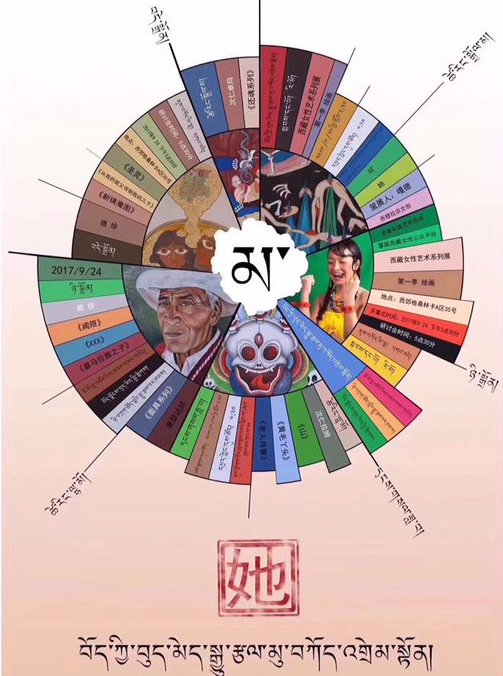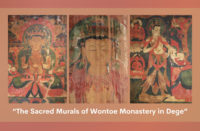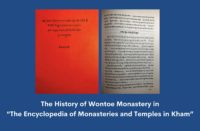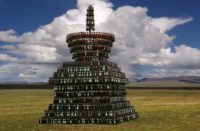
High Peaks Pure Earth has translated an article from a Tibetan Women’s WeChat Channel written by artist Gade. In this article, Gade gives a personal introduction to the female artists in an exhibition titled “HER”, which he also curated. The article was published on September 17, 2017, and the exhibition featuring five Tibetan female artists opened at the Scorching Sun Art Lab in Lhasa on September 24, 2017.
The Scorching Sun Art Lab in Lhasa is a pioneering and important space for Tibetan artists, founded by contemporary Tibetan artists Nortse and Gade. Earlier this year, High Peaks Pure Earth published an interview with Nortse about the space and last year, an interview with Gade.
As Gade mentions in the piece below, the Scorching Sun Art Lab will host further exhibitions by female artists and continue this “HER” series. Of the five female artists in this piece, Dedron and Nyedron have the highest international profile.
“HER” Part 1: Tibetan Female Art Exhibition Series
By Gade
Jomo Lhazom Cultural Group, Tibetan Women’s Platform and Scorching Sun Art Lab jointly launch “HER”. It is a series of exhibitions showing the works of outstanding Tibetan female artists in different artistic realms, including fine arts, literature, music, film, dance, fashion etc.
During each exhibition part, one artistic category will be chosen and displayed. In this way, we can do justice to each female artist and systematically prepare their works; also, each exhibition can thus be more thorough and profound. We really hope that this series can establish itself and continue and that female artists in various artistic realms, including their personal information, can be turned into and published in the form of a collective works. Plus, this is also a great opportunity to compile an archive and document contemporary female artists in Tibet for the future.
“HER”
In “HER” Part One, five female artists are exhibited: Tsering Dolma, Dangsel Dawa, Tsering Lhamo, Dedron, Nyedron.
I remember how over ten years ago, we once curated an exhibition on female artists in cooperation with the Gedun Choephel Artists Guild. The exhibiting artists were, of course, identical with the names above, apart from Nyedron. Even though over ten years have passed since, the name list has not changed much. Trying to find a new female face among Tibetan artists is really very tough.
I believe that this situation should be one of the problems that this exhibition reflects upon. Luckily, over the past more than ten years, the above female artists have never given up producing art; so now we are able to launch this exhibition.
Her paintings always remind me of the traditional “Lama Mani” (it is a kind of folk art that involves drawings and words). Especially the technique she uses to portray characters in her paintings has much resemblance with folk art.
Her works are not as exquisite as thangka paintings, in some cases even showing some slightly coarse strokes; they are simple and direct; but they are also piercingly smart, which is quite different from the characteristics usually attributed to female art works.
Her works are permeated with narratives, for example, her series titled “Birth,” “Age,” “Sickness,” “Death” as well as the “Returning from the Grave Series” that is shown at this exhibition. Narratives are generally excluded in western contemporary art and also in the Chinese painting system. But this is precisely the native language system of Tibetan art.
What is the distinctive form of narration of contemporary Tibetan art? This is a question that I have always been thinking about. I believe that the art of each region has to be rooted in its own context and cultural environment. Perhaps, we have been brainwashed by the thoughts of western modernism, our perspectives and ways of expression have been particularly drilled, perhaps we have long forgotten how to speak and express ourselves.
But Tsering Dolma has mastered this native way of expression, integrating it in her very personal experience. On the surface she seems to use paintings to depict the suffering of human life as narrated in Buddhist scriptures, but you will slowly realise that every single stroke tells Tsering Dolma’s very own story, narrating each period of her very own life.

Tsering Dolma
Born in 1966 in Lhasa; graduated in fine arts from the Department of Art of the University of Tibet; fine arts teacher at the Lhasa High School, Lhasa Normal Polytechnic etc.; member of the Chinese Artist Association; vice-chairperson of the Lhasa China Federation of Literary and Arts Association (CFLAC); her work “New Painting Show” was selected for the 6th national art exhibition; “Reincarnation” was nominated for the “Minority Hundred Flowers” award and entered the 4th China Minority Art Exhibition and others; many of her works were collected by different art organisations and collectors around the world.

Dedron
Looking at her works is a relaxing and happy experience. This is also her artistic vision, she wants people to enjoy her art. In the same way as Tsering Dolma, her works have their roots in traditional Tibetan art. As a student she indulged in models and colours of ancient Tibetan drawings; but she did not simply copy them, she also always added her own innovations, techniques and ways of expression, which led to the formation of her very own, unique artistic language.
Regardless of whether she depicts people, birds, flowers, fish or insects, her works are full of the spirituality and qualities of the plateau. I regard Dedron’s way of looking at things as particularly important, a very sharp and keen quality, it is a natural gift, which is very difficult to acquire through study. So all the life that she creates with her brush is full of spirituality. This is also a typical Tibetan way of expression, which is deeply rooted in the Tibetan artistic language system. Dedron managed to activate this system using her very own modes of artistic expression.
Over the past few years, Dedron’s works have shifted from depicting the bold and imaginative mysterious garden to her personal life, like “From my Grandparents to my Son.” It is very possible that this is related to her feelings and experiences as a mother. Her paintings, however, have still maintained that very distinctive Dedron style, that freedom, casualness, beauty and openness. This must be why so many people love her works.

Langdun Dedron
Born in 1976 in Lhasa; graduated in fine arts from the Department of Art of the University of Tibet; in 2009, she held her own art exhibition at Rossi & Rossi in London titled “Nearest to the Sun;” in 2011, she was honoured with the title “China Art Weekly Person of the Year;” in 2013, vice-chairperson of the Tibet Art Association and member of the China Art Association; in Italy, she held the “Dedron” exhibition; her works have been collected by the Likeran Arts Foundation, by art galleries in the UK and the US, museums and private collectors.
Her painting styles are varied and very difficult to classify. Her various artistic periods have produced their very own different styles and patterns. This may be related to her experience; she used to work as an art teacher at a Children’s Palace; she used to also be a kindergarten teacher and a civil servant. Later, she quit her government job and became a professional artist. As a single mother, she plunged into the sea of entrepreneurship and even had her own bar, bookshop, ceramics art shop etc. She has experienced a lot. But she never gave up painting and drawing. She says that she is most happy when she is in her studio painting. That is when she can forget all her worries and concentrate, it is like meditation.
She smiled and said: “Those who can paint are the happiest people.” The work “Mask Series” that is part of our exhibition make a gloomy colour in front of my eyes turn bright; she simply uses pure colours, which makes us feel that her artworks have a lot of potential. She likes to paint masks whose expressions are unambiguous, allowing us to directly see a person’s emotions. She said that she does not like painting real people’s faces because she has no way of telling what actually lies behind a facial expression; “Only a person’s real face would be a genuine mask”. I remember this sentence deeply. An artist’s career always splits into an early and a later period. I prefer the later period. Because of my experience, I believe that Dangsel Dawa’s paintings are at an early stage and that they are yet to blossom during her most brilliant period.

Dangsel Dawa
Member of the Lhasa Artist’s Association; once an art teacher at the Lhasa Children’s Palace; pursued advanced studies at the Zhejiang Art College and at the thangka painting class of Tibet University; studied two years of traditional thangka painting, during which she systematically studied traditional ethnic art; found her own entry point to a style that keeps up with contemporary trends, but that does not compromise traditional art; her work has been exhibited many times at fine art, photography and calligraphy exhibitions in Lhasa.
Tsering Lhamo
She has never regarded herself as a professional painter. Even though she graduated from the the Shanghai Theatrical Institute and has obtained excellent professional training, she prefers to regard artistic production as a relaxing leisure activity. Over the past few years, her main activities revolved around her family and work life. All of the costume design of the entire Tibet Autonomous Region’s dance ensemble “rests” on her shoulders. She also has to take care of her own stage art costumes studio. But she still cannot give up painting. Whenever she has time, she hides away in her studio to paint a few strokes. But she probably never thought about doing this for some purpose. She said that she really does not want to turn what she loves so much into something that has a special use. But even though she does not want to become a professional painter, she also says that she will probably keep painting for the rest of her life. This is because painting has already become an integral part of her life. Everyone says that the best way to destroy a hobby is by turning into a profession. In this respect, Tsering Lhamo is really fortunate.

Tsering Lhamo
Graduated from Shanghai Theatrical Institute with degrees in stage art and costume design and make-up design; now works as a second grade national costume artist for the TAR dance ensemble; her hobbies are oil painting; her oil painting “Potala Palace” was selected for a contemporary Tibetan art exhibition in Japan; her oil painting “The Autumn Field” was selected for the 8th national art exhibition.

Nyedron
She is the only artist at this exhibition who uses photography as a mode of expression. She is also the youngest among the five. She graduated with a distinction from the University of the Arts in London in fashion photography and design. What is the unique perspective of a Tibetan girl who was born in the 1990s and who returned from abroad? This is what I am interested in.
Tibet is a hotspot for photographers; but most pictures show the holy mountains and rivers and the vast grasslands or the beautiful Tibetan girls or the elderly herdsmen who are devout Buddhists; I call this the “Shangri-la perspective”. These photographers think about lighting effects, precision and the atmosphere of the vast plateau. But these people never think about the actual situation and feelings of the people they photograph; they simply keep reinforcing their image of Tibet.
Nyedron, on the other hand, looks at a Tibet under modernisation. She captures the collision between external cultural elements like LV bags, Coca-Cola or Versace glasses and traditional culture; loss and restructuring, rebellion and conservatism, these are the things that make up Nyedron’s visual discourse. A different but certainly existent Tibet.

Nyedron
Graduated from the University of the Arts in London in fashion photography and design; during her studies, her photographs made it into several fashion and art magazines the UK and in Europe; after graduating in 2015, she returned home and registered the Holy Mountain Photography Co. Ltd. in Lhasa; in 2016, Nyedron signed a contract with the London based art gallery Art Represent and some of her works were sold; after returning to Lhasa, Nyedron published her work in several fashion magazines in Tibet and Hong Kong.
Through these profound interviews, I have come to increasingly realise and feel the different societal experiences between females and males, it is what we would call “women’s unfavourable situation”. It is not only about their external social conditions, their restrictions due to traditional thinking or their physical differences, it is more about the unique female inner world.
Their mentality towards life and work changes, especially after becoming mothers. And these changes might very much impact their artistic production as well; this is especially true for Tibetan women who live in a very specific cultural context and traditional environment. What their modes of expression are under these circumstances is what our exhibition series “HER” hopes to convey and this is also where the true significance of it is to be found.
Finally, I would like to express my deepest gratitude to Jomo Lhazom Cultural Group’s Chairman Mr. Liu Yabin for his extraordinary support for this exhibition.
I am convinced that Jomo Lhazom Cultural Group will become a crucial force in promoting contemporary Tibetan art exhibitions.
Curator: Gade
Exhibition theme: “HER” 《她》《མ》
By: Jomo Lhazom Cultural Group, Tibetan Women’s Platform and Scorching Sun Art Lab
Opening: September 24 (Friday) at 15:30.
Opening ceremony and art discussion.










how to reach out to any of these Tibetan woman artists?